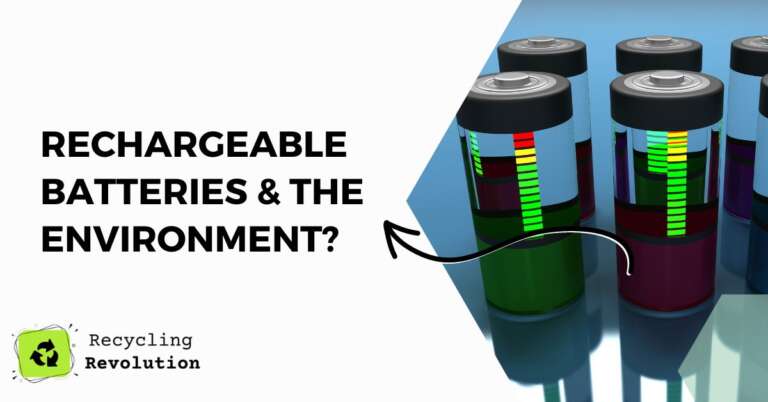You’re standing in the electronics aisle, staring at the vast selection of batteries, and you can’t help but wonder: are rechargeable batteries really better for the environment? It’s a common question that deserves an answer.
The short answer is Yes, rechargeable batteries are better for the environment. They can be recharged and reused hundreds of times, reducing the amount of waste produced.
Disposable batteries, on the other hand, are used once and then discarded, often ending up in landfills where they can contribute to soil and water pollution.
Environmental Impact of Disposable Batteries
Disposable batteries, particularly alkaline and lithium-ion batteries, are ubiquitous in our day-to-day life, powering everything from smartphones, power banks, Tesla vehicles to toys and more, this technology is everywhere.
However, they come with a significant environmental impact. The extent of this impact is determined by these factors including their manufacturing process, usage, and disposal.
Producing disposable batteries involves mining and processing raw materials, including toxic heavy metals such as cadmium and mercury. This process consumes vast amounts of energy and generates hazardous waste, contributing to air and water pollution.
Manufacturing Process: The manufacturing of disposable batteries is energy-intensive and involves the extraction and processing of raw materials. According to a study by Gaines and Cuenca (2000), the production of lithium-ion batteries requires significant amounts of energy, which is often derived from fossil fuels. Moreover, the extraction process for materials such as lithium, cobalt, and nickel can lead to deforestation, soil erosion, and contamination of water sources, impacting local ecosystems.
Usage: Although the usage phase of batteries is less impactful than manufacturing or disposal, it still contributes to their overall environmental footprint. Batteries convert chemical energy into electrical energy, but this process is not 100% efficient. Some energy is lost as heat, leading to less efficient energy use compared to wired power sources.
Disposal: Improper disposal of batteries is a major environmental concern. A study by Zhang et al. (2019) found that batteries can leach harmful chemicals such as mercury, cadmium, and lead into the environment if not disposed of properly. These can contaminate soil and water, affecting both wildlife and human health.
Moreover, only a small percentage of batteries are recycled worldwide. This is due to the complexity and cost of battery recycling processes, according to a report by the United Nations Environmental Programme (2017).
| Battery Type | Typical Lifespan | Environmental Impact | Health Risks | Decomposition Time |
|---|---|---|---|---|
| Nickel-Cadmium (NiCd) | 5-7 years | Cadmium is highly toxic and can pollute soil and water. | Cadmium is a carcinogen and can cause damage to lungs and kidneys if improperly handled. | It doesn’t decompose naturally; cadmium can persist indefinitely in the environment. |
| Nickel-Metal Hydride (NiMH) | 5-7 years | Less toxic than NiCd but still requires proper disposal to avoid pollution. | Overexposure can lead to irritation of eyes and skin. | Doesn’t decompose naturally; the metals can persist indefinitely in the environment. |
| Lithium-ion (Li-ion) | 2-3 years | Mining for lithium can lead to soil degradation and water contamination. | If improperly disposed, can cause skin and eye irritation. | Doesn’t decompose naturally; lithium can persist indefinitely in the environment. |
| Lead Acid | 4-6 years | Lead can contaminate soil and water sources. | Lead is highly toxic and can cause severe health issues including neurological damage. | Doesn’t decompose naturally; lead can persist indefinitely in the environment. |
Recycling and Disposal of Rechargeable Batteries
Rechargeable batteries, such as Nickel-Cadmium (NiCd), Nickel-Metal Hydride (NiMH), Lithium-ion (Li-ion), and Lead Acid batteries, contain heavy metals that can be harmful to the environment and human health if not disposed of properly.
As such, they should never be thrown in the trash but instead should be recycled through appropriate channels.
Here are some general steps for recycling and disposal of rechargeable batteries:
Battery Collection: Many electronics retailers, recycling centers, and community waste programs offer drop-off points for used rechargeable batteries. These organizations participate in programs like Call2Recycle, a non-profit that provides convenient locations to drop off rechargeable batteries for recycling.
Sorting: Once collected, the batteries are sorted by type, as different battery chemistries require different recycling processes.
Processing: The batteries are then processed in a specialized facility where they are broken down into their component parts.
- For NiCd and NiMH batteries, a high-temperature metal reclamation (HTMR) process is used to recover valuable metals like nickel and iron.
- For Li-ion batteries, a process called hydrometallurgical recycling can be used, which involves crushing the batteries and using solvents to dissolve the metals for recovery.
- Lead-acid batteries are broken apart and the lead and plastic are separated. The lead can be melted and used to make new batteries, while the plastic can be recycled into new plastic products.
Recovery and Reuse: The recovered materials can then be used to manufacture new products. For example, the recovered nickel can be used in the manufacture of stainless steel, while the recovered lead can be used to produce new lead-acid batteries.
How to Dispose of AA Batteries
Always check local regulations first. Alkaline batteries can often go in household trash, but it’s better to recycle if possible. Rechargeable and button cell batteries should be taken to a recycling center or a participating retailer, as they contain harmful heavy metals. Never dispose of them in regular trash.
Factors to Consider Between Rechargeable and Disposable Batteries
We recommend using rechargeable batteries where ever possible to cut down on the pollution footprint, we have included a table of what factors to consider.
| Factor | Rechargeable Batteries | Disposable Batteries |
|---|---|---|
| Usage Frequency | Best for frequently used devices. | Best for infrequently used devices. |
| Cost | Higher upfront cost, but cost-effective over time. | Lower upfront cost, but can become expensive over time. |
| Environmental Impact | Produces less waste, more environmentally friendly. | Produces more waste, less environmentally friendly. |
| Energy Efficiency | Can self-discharge when not in use. | Retains charge for longer periods. |
| Convenience | Requires a charger and time to recharge. | Ready to use immediately out of the pack. |
| Device Requirements | Some devices might not be compatible. | Generally compatible with most devices. |
| Battery Life | Lower capacity but reusable. | Higher capacity but single-use. |
| Safety | Risk of overheating if improperly used. | Generally safe, no risk of overheating. |
| Availability | Availability of the right type and charger can be an issue. | Generally widely available. |
Are There Environmentally Friendly Alternatives?
Believe it or not, the subject is currently being developed thanks to the urgent need for renewable energy for greener options and Solar has spearheaded the development of these new technologies, however have yet to see anything new come out.
- Fuel Cells: These convert chemical energy into electricity and can be refueled, but they’re generally larger and more expensive than batteries.
- Solar Cells: These convert sunlight directly into electricity. They’re used in some low-power devices and in larger systems like solar panels, but they’re not typically used as direct replacements for batteries.
- Mechanical Energy Storage: This includes methods like flywheels or compressed air. These are used in some large-scale applications, but aren’t typically practical for small devices.
- New Battery Technologies: Scientists are constantly working on new types of batteries that could be more efficient, longer-lasting, or more environmentally friendly than existing rechargeable batteries.
Conclusion
In summary, rechargeable batteries offer numerous advantages over disposable batteries, including a lower environmental impact, increased energy efficiency, and cost-effectiveness.
However, it’s essential to consider factors such as the purpose of the battery, frequency of use, and initial cost when making your decision.
As individuals and as a society, we should also prioritize the proper recycling and disposal of rechargeable batteries to further minimize their environmental impact. The choice is in your hands – make a decision that benefits both you and the planet.
FAQs
Are rechargeable batteries more eco-friendly?
Yes, rechargeable batteries are typically more eco-friendly than disposable batteries, as they can be reused multiple times, reducing resource consumption, waste generation, and transportation emissions.
What are the most environmentally friendly batteries?
Rechargeable batteries, such as nickel-metal hydride (NiMH) and lithium-ion, are generally considered the most environmentally friendly options due to their reusability and reduced environmental footprint compared to disposable batteries.
What are the disadvantages of rechargeable batteries?
Some disadvantages of rechargeable batteries include a higher upfront cost, the potential for decreased performance over time, and the complexity of recycling certain types of rechargeable batteries.
Do rechargeable batteries reduce waste?
Yes, rechargeable batteries can significantly reduce waste by minimizing the number of batteries that need to be produced, transported, and disposed of.
By reusing rechargeable batteries, you contribute to a decrease in resource consumption and waste generation, promoting a more sustainable and eco-friendly lifestyle.

